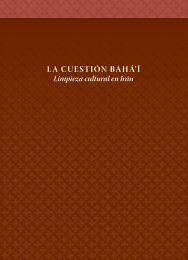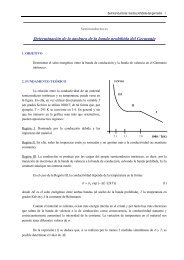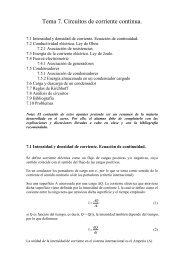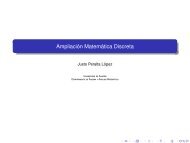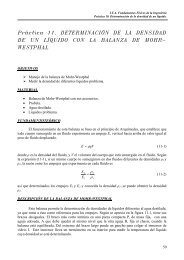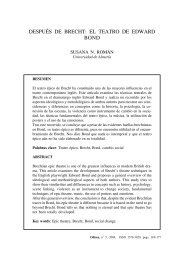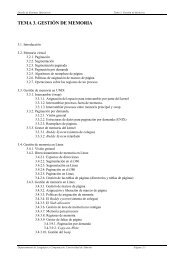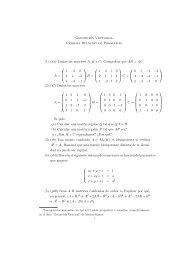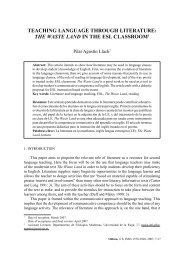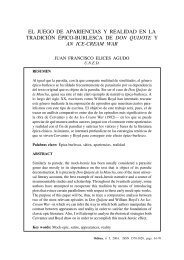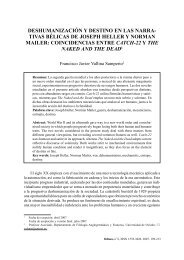Hopf Algebras and Tensor Categories - Universidad de Almería
Hopf Algebras and Tensor Categories - Universidad de Almería
Hopf Algebras and Tensor Categories - Universidad de Almería
Create successful ePaper yourself
Turn your PDF publications into a flip-book with our unique Google optimized e-Paper software.
<strong>Hopf</strong> <strong>Algebras</strong> <strong>and</strong> <strong>Tensor</strong> <strong>Categories</strong><br />
University of <strong>Almería</strong><br />
July 4-8, 2011<br />
Abstracts<br />
Sponsored by:
<strong>Hopf</strong> semialgebras<br />
Jawad Y. Abuhlail (King Fahd University of Petroleum & Minerals, Saudi Arabia)<br />
abuhlail@kfupm.edu.sa<br />
In this talk, we introduce <strong>and</strong> investigate the notions of semibialgebras <strong>and</strong> <strong>Hopf</strong><br />
semialgebras over semirings. We also investigate several related categories of Doi-<br />
Koppinen semimodules.<br />
Crossed product of <strong>Hopf</strong> algebras<br />
Ana L. Agore (Free University of Brussels, Belgium)<br />
ana.agore@gmail.com<br />
The main properties of the crossed product in the category of <strong>Hopf</strong> algebras<br />
are investigated. Let A <strong>and</strong> H be two <strong>Hopf</strong> algebras connected by two morphism<br />
of coalgebras ⊲ : H ⊗ A → A, f : H ⊗ H → A. The crossed product A# ⊲ f H is<br />
a new <strong>Hopf</strong> algebra containing A as a normal <strong>Hopf</strong> subalgebra. In fact, we prove<br />
that a <strong>Hopf</strong> algebra E is isomorphic as a <strong>Hopf</strong> algebra to a crossed product of <strong>Hopf</strong><br />
algebras A# ⊲ f H if <strong>and</strong> only if E factorizes through a normal <strong>Hopf</strong> subalgebra A<br />
<strong>and</strong> a subcoalgebra H such that 1E ∈ H. The universality of the construction,<br />
the existence of integrals, commutativity or involutivity of the crossed product are<br />
studied. The crossed product A# ⊲ f H is a semisimple <strong>Hopf</strong> algebra if <strong>and</strong> only if<br />
both <strong>Hopf</strong> algebras A <strong>and</strong> H are semisimple. Looking at the quantum si<strong>de</strong> of the<br />
construction we shall give necessary <strong>and</strong> sufficient conditions for a crossed product to<br />
be a coquasitriangular (brai<strong>de</strong>d) <strong>Hopf</strong> algebra. In particular, all brai<strong>de</strong>d structures<br />
on the monoidal category of A# ⊲ f H-comodules are explicitly <strong>de</strong>scribed in terms of<br />
their components.<br />
Bibliography<br />
[1] A.L. Agore, Crossed product of <strong>Hopf</strong> algebras. Preprint 2011.<br />
<strong>Hopf</strong> algebras <strong>and</strong> the geometry of real hyperplane<br />
arrangements<br />
Marcelo Aguiar (Texas A&M University, USA)<br />
maguiar@math.tamu.edu<br />
The starting point for our consi<strong>de</strong>rations is the notion of gra<strong>de</strong>d <strong>Hopf</strong> algebra,<br />
particularly those gra<strong>de</strong>d over the nonnegative integers. When the latter are replaced<br />
by finite sets, one arrives at the notion of <strong>Hopf</strong> monoid in Joyal’s category of species.<br />
The goal of this talk is to go one step further, replacing finite sets by finite real<br />
hyperplane arrangements. Geometric consi<strong>de</strong>rations allow us to <strong>de</strong>fine a generalized<br />
1
notion of “<strong>Hopf</strong> algebra” in this setting. The key ingredient in this construction is<br />
furnished by the projection maps of Tits. Algebraically, we construct a monad <strong>and</strong><br />
a comonad linked by a mixed distributive law in the sense of Beck.<br />
We will discuss these i<strong>de</strong>as without assuming familiarity with hyperplane arrangements<br />
or distributive laws. The case of finite sets (<strong>Hopf</strong> monoids in species) is<br />
recovered by restricting to braid arrangements. This will be used to illustrate the<br />
constructions.<br />
This is joint work in progress with Swapneel Mahajan.<br />
Polynomial i<strong>de</strong>ntities <strong>and</strong> gra<strong>de</strong>d algebras<br />
Eli Alja<strong>de</strong>ff (Technion-Israel Institute of Technology, Israel)<br />
elialja<strong>de</strong>ff@gmail.com<br />
We consi<strong>de</strong>r G-gra<strong>de</strong>d algebras <strong>and</strong> their corresponding gra<strong>de</strong>d i<strong>de</strong>ntities. In<br />
the lecture, I will present generalizations of some fundamental results in PI theory<br />
(originally proved by Kemer for G = {e}) in the context of G-gra<strong>de</strong>d algebras, where<br />
G is an arbitrary finite group. The same statements for H-comodule algebras (where<br />
H is an arbitrary semisimple <strong>Hopf</strong> algebra) are open.<br />
A presentation by generators <strong>and</strong> relations of Nichols<br />
algebras of diagonal type<br />
Iván Angiono (National University of Córdoba, Argentina)<br />
ivanangiono@gmail.com<br />
The Lifting Method of Andruskiewitsch <strong>and</strong> Schnei<strong>de</strong>r is the leading method to<br />
classify pointed <strong>Hopf</strong> algebras [1]. It involves as an inicial step to know for which<br />
brai<strong>de</strong>d vector spaces their associated Nichols algebra is finite-dimensional; such<br />
brai<strong>de</strong>d vector spaces were classified by Heckenberger [3].<br />
A second step is the following one: for each of these Nichols algebras, give a nice<br />
presentation by generators a relations. In the present talk we give an answer to this<br />
question, following [2]. We characterize convex or<strong>de</strong>rs on root systems associated to<br />
finite Weyl groupoids <strong>and</strong> use a <strong>de</strong>scription of coi<strong>de</strong>al subalgebras of Nichols algebras<br />
[4]. We <strong>de</strong>scribe then a set of relations using the PBW bases of [5].<br />
We use such presentation to prove that every finite-dimensional pointed <strong>Hopf</strong><br />
algebra over C, whose group of group-like elements is abelian, is generated by its<br />
group-like <strong>and</strong> skew-primitive elements, a conjecture due to Andruskiewitsch <strong>and</strong><br />
Schnei<strong>de</strong>r.<br />
Bibliography<br />
[1] N. Andruskiewitsch <strong>and</strong> H.-J. Schnei<strong>de</strong>r, On the classification of finite-dimensional<br />
pointed <strong>Hopf</strong> algebras. Ann. Math. 171 No. 1 (2010), 375–417.<br />
2
[2] I. Angiono, Presentation of Nichols algebras of diagonal type by generators <strong>and</strong><br />
relations, submitted. Preprint arXiv:1008.4144.<br />
[3] I. Heckenberger, Classification of arithmetic root systems. Adv. Math. 220<br />
(2009), 59–124.<br />
[4] I. Heckenberger <strong>and</strong> H.-J. Schnei<strong>de</strong>r, Right coi<strong>de</strong>al subalgebras of Nichols algebras<br />
<strong>and</strong> the Duflo or<strong>de</strong>r on the Weyl groupoid. Preprint arXiv:0909.0293.<br />
[5] V. Kharchenko, A quantum analog of the Poincare-Birkhoff-Witt theorem. Algebra<br />
<strong>and</strong> Logic 38 (1999), 259–276.<br />
Preantipo<strong>de</strong>s for dual-quasi bialgebras<br />
Aless<strong>and</strong>ro Ardizzoni (University of Ferrara, Italy)<br />
rdzlsn@unife.it<br />
It is known that a dual quasi-bialgebra with antipo<strong>de</strong> H, i.e. a dual quasi-<strong>Hopf</strong><br />
algebra, fulfils a fundamental theorem for right dual quasi-<strong>Hopf</strong> H-bicomodules. The<br />
converse in general is not true. We prove that, for a dual quasi-bialgebra H, the<br />
structure theorem amounts to the existence of a suitable endomorphism S of H that<br />
we call a preantipo<strong>de</strong> of H. This is based on joint work with Alice Pavarin (University<br />
of Padova, Italy), see arXiv:1012.1956.<br />
The central elements of the universal enveloping algebra of<br />
higher or<strong>de</strong>rs <strong>and</strong> the construction of<br />
Knizhik-Zamolodchikov type equations for root systems of<br />
types A,D,B<br />
Dmitry Artamonov (Moscow State University, Russia)<br />
artamonov.dmitri@gmail.com<br />
The talk is based on a joint work with V.A. Goloubeva (Moscow Aviational<br />
Institute, Russia).<br />
The talk is <strong>de</strong>voted to some generalization of the classical Riemann-Hilbert problem<br />
of construction of a Pfaffian system of fuchsian type, whose singular set is a<br />
collection of reflection hyperplanes <strong>de</strong>fined by a system of roots Bn. Also some new<br />
results are obtained for the root systems A <strong>and</strong> D.<br />
In construction of Knizhnik-Zamolodchikov equations, whose singular set is associated<br />
with the root system An, the Casimir element of the second or<strong>de</strong>r is used.<br />
In the case of root system Bn a similar construction was done by A. Leibman in one<br />
parameter case, while the corresponding equations must <strong>de</strong>pend on two parameters,<br />
as the number of orbits of the corresponding root system equals to two. For other<br />
root systems such constructions are not known.<br />
3
The Knizhnik-Zamolodchikov equations associated with the root system B have<br />
the following form:<br />
dy = λ � �<br />
i 1 any two irreducible H-modules of<br />
dimension d are isomorphic. The category of left H-modules HM is a monoidal<br />
category. In the talk we shall discuss Clebsch-Gordan coefficients in <strong>de</strong>compositions<br />
in HM of tensor products of irreducible H-modules. Some classifications results are<br />
obtained in the case when there exists up to an isomorphism a unique irreducible<br />
H-module of dimension greater than 1.<br />
Twisted partial <strong>Hopf</strong> actions<br />
Eliezer Batista (Fe<strong>de</strong>ral University of Santa Catarina, Brazil)<br />
eliezer1968@gmail.com<br />
The notion of a twisted partial <strong>Hopf</strong> action is a natural generalization of both,<br />
twisted partial group actions <strong>and</strong> partial <strong>Hopf</strong> actions. The twisted partial group<br />
actions arise in the context of gra<strong>de</strong>d algebras, allowing them to be classified as<br />
crossed products. The partial actions <strong>and</strong> coactions of <strong>Hopf</strong> algebras were originally<br />
used to put partial Galois extensions of commutative algebras in a broa<strong>de</strong>r context<br />
of Galois corings. In this work, we <strong>de</strong>fine a twisted partial action of a <strong>Hopf</strong> algebra<br />
on a unital algebra, construct partial crossed products <strong>and</strong> relate them with partially<br />
cleft extensions. The globalization theorem for twisted partial <strong>Hopf</strong> actions is also<br />
discussed.<br />
4
Classifying <strong>Hopf</strong> algebras of a given dimension<br />
Margaret Beattie (Mount Allison University, Canada)<br />
mbeattie@mta.ca<br />
Over an algebraically closed field, the problem of classifying all <strong>Hopf</strong> algebras<br />
even for some given small dimension, such as 16 or 32, or for a class of dimensions,<br />
such as p, pq , pq 2 , etc, for p, q prime, is a difficult one. Some recent techniques<br />
using the coradical filtration are due to D. Fukuda; he applied these to dimensions<br />
18 <strong>and</strong> 30. Cheng <strong>and</strong> Ng have recently investigated <strong>Hopf</strong> algebras of dimension p in<br />
the Yetter-Drinfeld category over the 4-dimensional Sweedler <strong>Hopf</strong> algebra <strong>and</strong> used<br />
these results to study dimension 4p. They show that <strong>Hopf</strong> algebras of dimensions<br />
20, 28, or 44 are either semisimple, pointed or copointed.<br />
In this talk some more techniques will be mentioned with applications to dimension<br />
p 3 in mind. <strong>Hopf</strong> algebras of dimension 27 will be completely <strong>de</strong>scribed.<br />
This is joint work with G.A. García.<br />
Finite quantum groups <strong>and</strong> quantum permutation groups<br />
Julien Bichon (University Blaise Pascal, Clermont-Ferr<strong>and</strong> II, France)<br />
Julien.Bichon@math.univ-bpclermont.fr<br />
This talk reports on joint work with Teodor Banica <strong>and</strong> Sonia Natale (arXiv:1104.<br />
1400).<br />
A quantum permutation algebra is a <strong>Hopf</strong> algebra having the diagonal algebra<br />
k n as a faithful comodule algebra. The corresponding quantum group acts faithfully<br />
on a finite classical space <strong>and</strong> is called a quantum permutation group. Several unexpected<br />
<strong>Hopf</strong> algebras appear as quantum permutation algebras <strong>and</strong> so it is natural<br />
to ask if any finite-dimensional semisimple <strong>Hopf</strong> algebra is a quantum permutation<br />
algebra, i.e., if a Cayley theorem holds for finite quantum groups. We show, by consi<strong>de</strong>ring<br />
bicrossed products associated to exact factorizations of finite groups, the<br />
existence of a semisimple <strong>Hopf</strong> algebra of dimension 24 that is not a quantum permutation<br />
algebra. This example is minimal since on the other h<strong>and</strong>, we show that<br />
any semisimple <strong>Hopf</strong> algebra of dimension less than 23 is a quantum permutation<br />
algebra.<br />
Weak bimonads <strong>and</strong> weak <strong>Hopf</strong> monads<br />
Gabriella Böhm (Research Institute for Particle <strong>and</strong> Nuclear Physics, Budapest,<br />
Hungary)<br />
bgabr@rmki.kfki.hu<br />
An algebra over a commutative ring is known to be a bialgebra if <strong>and</strong> only if<br />
its category of (left or right) modules is monoidal such that the forgetful functor<br />
5
is strong monoidal. By analogy, a monad can be called a ”bimonad” whenever<br />
its Eilenberg-Moore category is monoidal such that the forgetful functor is strong<br />
monoidal. A bimonad in this sense was proved to be the same as an opmonoidal<br />
monad, see recent works by Moerdijk, Mc Crud<strong>de</strong>n <strong>and</strong> others.<br />
More generally, an algebra over a commutative ring is known to be a weak<br />
bialgebra if <strong>and</strong> only if its category of (left or right) modules is monoidal such that<br />
the forgetful functor possesses a so-called separable Frobenius monoidal structure.<br />
By analogy, we <strong>de</strong>fine a ”weak bimonad” as a monad with additional structures<br />
that are equivalent to the monoidality of its Eilenberg-Moore category such that the<br />
forgetful functor is separable Frobenius monoidal. Whenever in the base category<br />
i<strong>de</strong>mpotent morphisms split, a simple set of axioms is provi<strong>de</strong>d, that characterizes<br />
the monoidal structure of the Eilenberg-Moore category as a weak lifting of the<br />
monoidal structure of the base category. The relation to bimonads, <strong>and</strong> the relation<br />
to weak bialgebras in a brai<strong>de</strong>d monoidal category are revealed. We also discuss<br />
antipo<strong>de</strong>s, obtaining the notion of weak <strong>Hopf</strong> monad.<br />
The talk is based on the paper [G. Böhm, S. Lack <strong>and</strong> R. Street, Weak bimonads<br />
<strong>and</strong> weak <strong>Hopf</strong> monads. J. Algebra 328 (2011), 1-30].<br />
Galois-Grothendieck duality, Tannaka duality <strong>and</strong> <strong>Hopf</strong><br />
(co)monads<br />
Alain Bruguieres (University of Montpellier, France)<br />
bruguier@math.univ-montp2.fr<br />
In SGA 1, Alex<strong>and</strong>re Grothendieck <strong>de</strong>fines the algebraic fundamental group of<br />
an scheme S. As is his wont, Grothendieck adopts a very general setting: given an<br />
abstract category C (think of it as the category of étale coverings of S) endowed with<br />
a functor ω to finite sets, satisfying certain conditions, Grothendieck constructs a<br />
profinite group G, the group of automorphisms of ω, <strong>and</strong> shows that C is equivalent<br />
to the category of continuous finite G-sets.<br />
Similarly, Tannaka duality (in the larger sense) associates with a tensor category<br />
C endowed with a fiber functor ω a sort of group G (affine group, gerbe in the commutative<br />
setting, <strong>Hopf</strong> algebra, <strong>Hopf</strong> algebroid in the non-commutative setting) in<br />
such a way that C is equivalent to the category of finite dimensional representations<br />
of G.<br />
We will propose a general setting which encompasses these two analogous situations;<br />
given a monoidal functor ω : C → B, we will show that, un<strong>de</strong>r general<br />
conditions on C, B <strong>and</strong> ω, there exists a <strong>Hopf</strong> monad T on B such that the category<br />
of ind-objects of C is equivalent to the category of ’representations’ of T , <strong>and</strong> C<br />
itself, to the category of representations ’of finite type’ of T .<br />
<strong>Hopf</strong> monads generalize groups <strong>and</strong> <strong>Hopf</strong> algebras in a non-brai<strong>de</strong>d setting.<br />
We will also explain how this result yields Galois-Grothendieck duality as well<br />
as Tannaka duality, <strong>and</strong> other results on tensor functors.<br />
6
On cross product <strong>Hopf</strong> algebras<br />
Daniel Bulacu (University of Bucharest, Romania)<br />
daniel.bulacu@fmi.unibuc.ro<br />
For A, B algebras <strong>and</strong> coalgebras but not necessarily bialgebras in a brai<strong>de</strong>d<br />
monoidal category C we give necessary <strong>and</strong> sufficient conditions for which a cross<br />
product algebra <strong>and</strong> a cross coproduct coalgebra structure afford on A ⊗ B a bialgebra<br />
structure in C. We also find sufficient conditions for which such a cross product<br />
bialgebra is a <strong>Hopf</strong> algebra in C. We then <strong>de</strong>scribe those cross product <strong>Hopf</strong> algebras<br />
that are a double cross (co)product, a biproduct or, more generally, a smash<br />
(co)product <strong>Hopf</strong> algebra, respectively, <strong>and</strong> to each of them we associate the appropriate<br />
<strong>Hopf</strong> algebra projection context.<br />
Clifford theory for semisimple <strong>Hopf</strong> algebras<br />
Sebastian Burciu (Institute of Mathematics ”Simion Stoilow” of the Romanian<br />
Aca<strong>de</strong>my, Romania)<br />
smburciu@syr.edu<br />
The classical Clifford correspon<strong>de</strong>nce for normal subgroups is consi<strong>de</strong>red in the<br />
setting of semisimple <strong>Hopf</strong> algebras. We prove that this correspon<strong>de</strong>nce still holds<br />
if the extension <strong>de</strong>termined by the normal <strong>Hopf</strong> subalgebra is cocentral. Other<br />
particular situations where Clifford theory also works will be discussed. This talk<br />
is based on the paper [Clifford theory for cocentral extension. Israel J. Math 181<br />
(2011), 111-123] <strong>and</strong> some work in progress of the author.<br />
Monoidal structures on the category of relative <strong>Hopf</strong><br />
modules<br />
Stefaan Caenepeel (Free University of Brussels, Belgium)<br />
scaenepe@vub.ac.be<br />
This talk is based on a joint work with Daniel Bulacu.<br />
Let B be a bialgebra, <strong>and</strong> A a left B-comodule algebra in a brai<strong>de</strong>d monoidal<br />
category C, <strong>and</strong> assume that A is also a coalgebra, with a not-necessarily associative<br />
or unital left B-action. Then we can <strong>de</strong>fine a right A-action on the tensor product<br />
of two relative <strong>Hopf</strong> modules, <strong>and</strong> this <strong>de</strong>fines a monoidal structure on the category<br />
of relative <strong>Hopf</strong> modules if <strong>and</strong> only if A is a bialgebra in the category of left Yetter-<br />
Drinfeld modules over B.<br />
7
On sheets of conjugacy classes in reductive algebraic groups<br />
Giovanna Carnovale (University of Padova, Italy)<br />
carnoval@math.unipd.it<br />
The representation theory of Ue(g), the non-restricted quantized enveloping algebra<br />
of a semisimple Lie algebra g at the roos of 1, is strictly related to the conjugacy<br />
classes in the (adjoint) algebraic group G whose Lie algebra is g. De Concini, Kac<br />
<strong>and</strong> Procesi constructed a map associating a conjugacy class C of G to each simple<br />
Ue(g)-module V <strong>and</strong> conjectured in the early 90’s a relation between the dimensions<br />
of V <strong>and</strong> C. Motivated by this connection, we classify certain families of conjugacy<br />
classes in G, called ”sheets”, <strong>and</strong> we <strong>de</strong>scribe sheets explicitly. After reporting on<br />
the state of the art of the subject, we show how our results can be used in or<strong>de</strong>r<br />
to refine the conjecture. This talk is based on joint work with Francesco Esposito<br />
(Padova).<br />
Interrelations between <strong>Hopf</strong> algebras <strong>and</strong> their duals -<br />
proposed new directions<br />
Miriam Cohen (Ben Gurion University of the Negev, Israel)<br />
mia@math.bgu.ac.il<br />
An essential property of finite-dimensional <strong>Hopf</strong> algebras is that they are Frobenius<br />
algebras <strong>and</strong> hence are strongly related to their duals. The Frobenius map<br />
enabled us to <strong>de</strong>fine the concept of ”conjugacy classes” for semisimple <strong>Hopf</strong> algebras<br />
H. With additional structural properties on H, the map was also used to <strong>de</strong>fine<br />
a Fourier transform on H. We shall review the basic i<strong>de</strong>as involved <strong>and</strong> suggest new<br />
directions in which to generalize some theorems from group theory to <strong>Hopf</strong> algebras.<br />
We shall also discuss some aspects of the theory when H is no longer semisimple.<br />
Computing of the combinatorial rank of quantum groups<br />
Mayra Lorena Diaz Sosa (Autonomous National University of Mexico, Mexico)<br />
malodi1982@yahoo.com.mx<br />
In general an intersection of two bii<strong>de</strong>als is not a bii<strong>de</strong>al. By this reason one<br />
may not <strong>de</strong>fine a bii<strong>de</strong>al generated by a set of elements, <strong>and</strong> the bialgebras do not<br />
admit a usual combinatorial representation by generators <strong>and</strong> relations. Heyneman-<br />
Radford theorem implies that each nonzero bii<strong>de</strong>al of a pointed bialgebra has a<br />
nonzero skew primitive element. Each i<strong>de</strong>al generated by skew primitive elements<br />
is a bii<strong>de</strong>al, but certainly a bii<strong>de</strong>al in general is not generared as an i<strong>de</strong>al by its<br />
skew primitive elemens. The Heyneman-Radford theorem allows one to <strong>de</strong>fine a<br />
combinatorial representation over the coradical in the following form:<br />
A = C〈X ||F1 = 0|F2 = 0| . . . |Fκ = 0|〉,<br />
8
where X is a set of generators, F1 is a set of skew primitive relations, Fi, 1 < i ≤ κ<br />
is a set of relations that are skew primitive in C〈X ||F1 = 0|F2 = 0| . . . |Fi−1 = 0|〉.<br />
The minimal number κ is called the combinatorial rank of A. We prove that the<br />
combinatorial rank of the multiparameter version of the Lusztig small quantum<br />
group uq(so2n+1), or equivalently of the Frobenius-Lusztig kernel of type Bn, equals<br />
⌊log 2(n − 1)⌋ + 2 provi<strong>de</strong>d that q has a finite multiplicative or<strong>de</strong>r t > 4. In the case<br />
An the combinatorial rank equals ⌊log 2 n⌋ + 1, see [1].<br />
Bibliography<br />
[1] V.K. Kharchenko, A. Andra<strong>de</strong> Álvarez, On the combinatorial rank of <strong>Hopf</strong><br />
algebras. Contemp. Math. 376 (2005), 299-308.<br />
Twisted homogeneous racks of type D<br />
Fern<strong>and</strong>o Fantino (National University of Córdoba, Argentina)<br />
fantino@famaf.unc.edu.ar<br />
The problem of classifying finite-dimensional pointed <strong>Hopf</strong> algebras over nonabelian<br />
finite groups reduces in many cases to a question on conjugacy classes or,<br />
more generally, on (twisted homogeneous) racks <strong>and</strong> 2-cocycles. The racks of type<br />
D are a distinguished family of racks since they give arise to Nichols algebras of<br />
dimension infinite for any cocycle.<br />
In this talk, we present some techniques to check when a twisted homogeneous<br />
rack (THR) is of type D <strong>and</strong> present a list of known THR of type D for alternating<br />
<strong>and</strong> sporadic groups.<br />
Bibliography<br />
[1] N. Andruskiewitsch, G. A. García, F. Fantino <strong>and</strong> L. Vendramin, On twisted<br />
homogeneous racks of type D. Rev. Unión Mat. Argent. 51 No. 2 (2010),<br />
1-16.<br />
[2] —–, On Nichols algebras associated to simple racks. Contemp. Math., to<br />
appear. Preprint arXiv:1006.5727.<br />
[3] F. Fantino <strong>and</strong> L. Vendramin, On twisted conjugacy classes of type D in sporadic<br />
groups. In preparation.<br />
9
The <strong>Hopf</strong> automorphism group <strong>and</strong> the quantum Brauer<br />
group<br />
Bojana Femić (University of the Republic, Uruguay)<br />
femicenelsur@gmail.com<br />
We lift a known exact sequence for the quantum Brauer group of a <strong>Hopf</strong> algebra<br />
over a commutative ring to the level of a brai<strong>de</strong>d monoidal category. This permits<br />
one to get new relations that <strong>de</strong>scribe the quantum Brauer group of a <strong>Hopf</strong> algebra<br />
H over a field k. Let B be a <strong>Hopf</strong> algebra in C = H H<br />
YD, the category of Yetter-<br />
Drinfel’d modules over H. We consi<strong>de</strong>r the quantum Brauer group BQ(C; B) of B<br />
in C, which is isomorphic to the usual quantum Brauer group BQ(k; B ⋊ H) of the<br />
Radford biproduct <strong>Hopf</strong> algebra B ⋊ H. We find that un<strong>de</strong>r a certain symmetricity<br />
condition on the braiding in C, there is an inner action of the <strong>Hopf</strong> automorphism<br />
group of B on the former. We use this fact to generate a new subgroup of the<br />
quantum Brauer group for a family of Radford biproduct <strong>Hopf</strong> algebras B ⋊ H.<br />
Applying our recent results on the subgroup BM(k; B ⋊ H) - the Brauer group of<br />
module algebras over B ⋊H, - we obtain new estimations of the respective quantum<br />
Brauer group. In particular, we get new information on the quantum Brauer group<br />
of some known <strong>Hopf</strong> algebras.<br />
Compact coalgebras, daggers <strong>and</strong> Tannakian reconstruction<br />
Walter Ferrer Santos (University of the Republic, Uruguay)<br />
wrferrer@gmail.com<br />
From the viewpoint of Tannakian reconstruction, <strong>and</strong> with the i<strong>de</strong>a of un<strong>de</strong>rst<strong>and</strong>ing<br />
the reconstruction of compact quantum groups, we consi<strong>de</strong>r the simple<br />
case of coalgebras. We consi<strong>de</strong>r the concept of compactness for o-coalgebras <strong>and</strong><br />
characterize the notion of compactness in terms of the extension of the dagger functor<br />
from V ect to the category of C-comodules.<br />
This is joint work with Ignacio López Franco (University of Cambridge, Engl<strong>and</strong>).<br />
Clifford theory for gra<strong>de</strong>d fusion categories<br />
César Galindo (University of the An<strong>de</strong>s, Colombia)<br />
cesarneyit@gmail.com<br />
I will report on progress towards the classification of module categories over<br />
gra<strong>de</strong>d fusion categories. We <strong>de</strong>velop a categorical analogue over gra<strong>de</strong>d fusion categories<br />
of Clifford theory for strongly gra<strong>de</strong>d rings. We <strong>de</strong>scribe module categories<br />
over a fusion category C gra<strong>de</strong>d by a group G as induced from module categories<br />
over fusion subcategories associated with the subgroups of G. We <strong>de</strong>fine invariant<br />
10
Ce-module categories <strong>and</strong> extensions of Ce-module categories. The construction of<br />
module categories over C is reduced to <strong>de</strong>termine invariant module categories for<br />
subgroups of G <strong>and</strong> the in<strong>de</strong>composable extensions of this modules categories. We<br />
associate a G-crossed product fusion category to each G-invariant Ce-module category<br />
<strong>and</strong> give a criterion for a gra<strong>de</strong>d fusion category to be a group-theoretical<br />
fusion category. We give necessary <strong>and</strong> sufficient conditions for an in<strong>de</strong>composable<br />
module category to be exten<strong>de</strong>d.<br />
On pointed <strong>Hopf</strong> algebras over dihedral groups<br />
Gastón Andrés García (National University of Córdoba, Argentina)<br />
gaston<strong>and</strong>resg@gmail.com<br />
Let k be an algebraically closed field of characteristic 0 <strong>and</strong> let Dm be the dihedral<br />
group of or<strong>de</strong>r 2m with m = 4t; t ≥ 3. This talk will be based on a joint work with<br />
Fern<strong>and</strong>o Fantino [2], where we classify all finite-dimensional Nichols algebras over<br />
Dm <strong>and</strong> all finite-dimensional pointed <strong>Hopf</strong> algebras whose group of group-likes is<br />
Dm, by means of the Lifting Method. As a byproduct we obtain new examples of<br />
finite-dimensional pointed <strong>Hopf</strong> algebras. In particular, we give an infinite family of<br />
non-abelian groups with non-trivial examples of pointed <strong>Hopf</strong> algebras over them <strong>and</strong><br />
where the classification is completed. The difference with the case of the symmetric<br />
groups S3 y S4, see [1] <strong>and</strong> [3], respectively, is that each dihedral group provi<strong>de</strong> an<br />
infinite family of new examples.<br />
Bibliography<br />
[1] N. Andruskiewitsch, I. Heckenberger <strong>and</strong> H-J. Schnei<strong>de</strong>r, The Nichols algebra<br />
of a semisimple Yetter-Drinfeld module. Amer. J. Math. 132 No. 6 (2010),<br />
1493-1547.<br />
[2] F. Fantino <strong>and</strong> G.A. García, On pointed <strong>Hopf</strong> algebras over dihedral groups.<br />
To appear in Pacific J. of Math. Preprint arXiv:1007.0227.<br />
[3] G.A. García <strong>and</strong> A. García Iglesias, Finite dimensional pointed <strong>Hopf</strong> algebras<br />
over S4. Israel J. Math. 183 (2011), 417-444.<br />
Representations of the category of modules over pointed<br />
<strong>Hopf</strong> algebras over S3 <strong>and</strong> S4<br />
Agustín García Iglesias (National University of Córdoba, Argentina)<br />
agustingarcia8@gmail.com<br />
This is a joint work with Martín Mombelli. It will appear in Pacific Journal of<br />
Mathematics. A preprint is available at arXiv:1006.1857v1[math.QA].<br />
11
We will recall the basic results on module categories over finite-dimensional <strong>Hopf</strong><br />
algebras [2], [4] <strong>and</strong> the classification of finite-dimensional <strong>Hopf</strong> algebras with coradical<br />
kS3 or kS4 from [1], [3], respectively.<br />
Using these results, we will show that if n = 3, 4 <strong>and</strong> M is an exact in<strong>de</strong>composable<br />
module category over Rep(B(X, q)#kSn), then there exist<br />
• a subgroup F < Sn <strong>and</strong> a 2-cocycle ψ ∈ Z 2 (F, k × ),<br />
• a subset Y ⊆ X invariant un<strong>de</strong>r the action of F ,<br />
• a family of scalars {ξC} compatible with (F, ψ, Y ),<br />
such that M � B(Y,F,ψ,ξ)M, where B(Y, F, ψ, ξ) is a left B(X, q)#kSn-comodule<br />
algebra constructed from data (Y, F, ψ, ξ). We also show a classification of connected<br />
homogeneous left coi<strong>de</strong>al subalgebras B(Y, F, ψ, ξ) of gr H <strong>and</strong> together with<br />
a presentation by generators <strong>and</strong> relations.<br />
Finally we prove that if H is a finite-dimensional <strong>Hopf</strong> algebra with coradical kS3<br />
or kS4 then H <strong>and</strong> gr H are cocycle <strong>de</strong>formations of each other, a result analogous<br />
to a theorem of Masuoka for abelian groups. This implies that there is a bijective<br />
correspon<strong>de</strong>nce between module categories over Rep(H) <strong>and</strong> Rep(gr H).<br />
Bibliography<br />
[1] N. Andruskiewitsch, I. Heckenberger <strong>and</strong> H.J. Schnei<strong>de</strong>r, The Nichols algebra<br />
of a semisimple Yetter-Drinfeld module. Amer. J. Math. 132 No. 6 (2010),<br />
1493-1547.<br />
[2] N. Andruskiewitsch <strong>and</strong> M. Mombelli, On module categories over finite-dimensional<br />
<strong>Hopf</strong> algebras. J. Algebra 314 (2007), 383–418.<br />
[3] G.A. García <strong>and</strong> A. García Iglesias, Finite dimensional pointed <strong>Hopf</strong> algebras<br />
over S4. Israel J. Math. 183 (2011), 417-444.<br />
[4] M. Mombelli, Representations of tensor categories coming from quantum linear<br />
spaces. J. London Math. Soc. (2) 83 (2011), 19–35.<br />
Weak factorizations<br />
José Gómez-Torrecillas (University of Granada, Spain)<br />
gomezj@ugr.es<br />
We will look to a weak factorization theorem for monads in a general bicategory,<br />
with an eye on weak bialgebras. Most of the results are obtained in collaboration<br />
with Gabriella Böhm.<br />
12
The Miyashita-Ulbrich action for weak <strong>Hopf</strong> algebras<br />
Ramón González Rodríguez (University of Vigo, Spain)<br />
rgon@dma.uvigo.es<br />
In this talk we show that for every weak Galois extension B ↩→ A associated to a<br />
weak <strong>Hopf</strong> algebra in a symmetric closed category with equalizers <strong>and</strong> coequalizers,<br />
the centralizer of B in A, <strong>de</strong>noted by CA(B), is a H-module algebra <strong>and</strong> a Yetter-<br />
Drinfeld module via the so-called Miyashita-Ulbrich action. We also prove that there<br />
exists a lax monoidal functor C−(B) : AMA → MH with factorization through the<br />
category CA(B)(MH) (i.e., the category of relative <strong>Hopf</strong> modules) <strong>and</strong> we obtain<br />
explicitly the form of the Miyashita-Ulbrich action when we work with weak H-cleft<br />
extensions. If the functor −⊗H preservers equalizers, we show that there exists a lax<br />
monoidal functor Y C−(B) : A(MH )A → YDH H generalizing the result obtained by<br />
Peter Schauenburg in [4]. As a consequence, if the antipo<strong>de</strong> of H is an isomorphism,<br />
using the results proved in [2] we obtain that every weak H-Galois extension gives<br />
rise a non-trivial weak Yang-Baxter operator (see [2] <strong>and</strong> [1] for the <strong>de</strong>finition <strong>and</strong><br />
properties). Finally, we prove that CA(B) is a commutative algebra in YDH H <strong>and</strong><br />
the functor Y C−(B) factors through the category CA(B)(YD H H ).<br />
Bibliography<br />
[1] J.N. Alonso Álvarez, J.M. Fernán<strong>de</strong>z Vilaboa, R. González Rodríguez, Weak<br />
brai<strong>de</strong>d <strong>Hopf</strong> algebras. Indiana Univ. Math. J. 57 (2008), 2423-2458.<br />
[2] —–, Weak <strong>Hopf</strong> algebras <strong>and</strong> weak Yang-Baxter operators. J. Algebra 320<br />
(2008), 2101-2143.<br />
[3] —–, The Miyashita-Ulbrich action for weak <strong>Hopf</strong> algebras. Comm. Algebra<br />
39 No. 5 (2011), 1826-1871.<br />
[4] P. Schauenburg, <strong>Hopf</strong> bimodules over <strong>Hopf</strong>-Galois extensions, Miyashita-Ulbrich<br />
actions, <strong>and</strong> monoidal center constructions. Comm. Algebra 24 (1996), 143-<br />
163.<br />
On the duality of generalized <strong>Hopf</strong> <strong>and</strong> Lie algebras<br />
Isar Goyvaerts (Free University of Brussels, Belgium)<br />
isar.goyvaerts@vub.ac.be<br />
Michaelis [1] introduced the notion of a Lie coalgebra <strong>and</strong> proved [2] the following<br />
duality property for any <strong>Hopf</strong> algebra H:<br />
P (H ◦ ) ∼ = Q(H) ∗ .<br />
Here P is the functor that assigns to every <strong>Hopf</strong> algebra the Lie algebra of primitive<br />
elements <strong>and</strong> Q is the dual functor, introduced by Michaelis, that assigns to every<br />
13
<strong>Hopf</strong> algebra the Lie coalgebra of in<strong>de</strong>composables. H ◦ is the Sweedler dual of H<br />
<strong>and</strong> (−) ∗ is our notation for the vector space dual, that in particular turns a Lie<br />
coalgebra structure into a Lie algebra structure.<br />
Since the work of Michaelis, the notion of a <strong>Hopf</strong> algebra has known several<br />
generalizations <strong>and</strong> different kinds of dualities on the category of (generalized) <strong>Hopf</strong><br />
algebras have been introduced, in particular to cover the apparent dualities in the<br />
theory of quantum groups. The aim of the work that is presented here, is to lift these<br />
dualities for <strong>Hopf</strong> algebras to the Lie algebra level, in the same spirit as Michaelis’<br />
theorem.<br />
Bibliography<br />
[1] W. Michaelis, Lie Coalgebras. Adv. Math. 38 (1980), 1–54.<br />
[2] W. Michaelis, The primitives of the continuous linear dual of a <strong>Hopf</strong> algebra<br />
as the dual Lie algebra of a Lie coalgebra. In: “Lie algebra <strong>and</strong> related topics<br />
(Madison, WI, 1988)”, Contemp. Math. 110, 125–176. Amer. Math. Soc.,<br />
Provi<strong>de</strong>nce, RI, 1990.<br />
Deformations of a class of gra<strong>de</strong>d <strong>Hopf</strong> algebras with<br />
quadratic relations<br />
Jiwei He (Shaoxing University, China)<br />
jwhe@usx.edu.cn<br />
We consi<strong>de</strong>r a special class of gra<strong>de</strong>d <strong>Hopf</strong> algebras, which are finitely generated<br />
quadratic algebras with anti-symmetric generating relations. We discuss the<br />
automorphism group <strong>and</strong> Calabi-Yau property of a PBW-<strong>de</strong>formation of such a<br />
<strong>Hopf</strong> algebra. We show that the Calabi-Yau property of a PBW-<strong>de</strong>formation of<br />
such a <strong>Hopf</strong> algebra is equivalent to that of the corresponding augmented PBW<strong>de</strong>formation<br />
un<strong>de</strong>r some mild conditions.<br />
Nichols algebras with many cubic relations<br />
István Heckenberger (University of Marburg, Germany)<br />
heckenberger@Mathematik.Uni-Marburg.<strong>de</strong><br />
The talk is based on a joint work with A. Lochmann <strong>and</strong> L. Vendramin. We<br />
classify Nichols algebras of irreducible Yetter-Drinfeld modules over groups un<strong>de</strong>r the<br />
assumption that the un<strong>de</strong>rlying rack is brai<strong>de</strong>d <strong>and</strong> the homogeneous component of<br />
<strong>de</strong>gree three of the Nichols algebra satisfies a given inequality. This assumption turns<br />
out to be equivalent to a factorization assumption on the Hilbert series. Besi<strong>de</strong>s<br />
the known Nichols algebras, a new example is obtained. The proof is based on a<br />
combinatorial invariant of the Hurwitz orbits with respect to the action of the braid<br />
group on three str<strong>and</strong>s.<br />
14
Serial <strong>and</strong> co-Frobenius coalgebras, infinite abelian groups,<br />
<strong>and</strong> a class of quantum groups<br />
Miodrag Iovanov (University of Southern California, USA/University of Bucharest,<br />
Romania)<br />
yovanov@gmail.com<br />
We present some recent classification results of co-Frobenius coalgebra structures<br />
on monomial subcoalgebras of path coalgebras, <strong>and</strong> of an associated class of quantum<br />
groups. These coalgebras are also serial coalgebras; we show how some of these<br />
results follow alternatively from a classification of left serial coalgebras. We answer<br />
several open questions regarding co-representations of such coalgebras, <strong>and</strong> show<br />
how methods of the theory of infinite abelian groups apply to this context. Finally,<br />
we look at a conjecture of Andruskiewitsch <strong>and</strong> Dăscălescu (which states that a <strong>Hopf</strong><br />
algebra with nonzero integral must have finite coradical filtration); we examine this<br />
from the point of view of tensor categories but also from the perspective of such<br />
combinatorial examples of co-Frobenius coalgebras, <strong>and</strong> investigate the question of<br />
when an in<strong>de</strong>composable co-Frobenius coalgebra must have finite coradical filtration.<br />
Combinatorial representation of quantum groups <strong>and</strong><br />
related problems<br />
Vladislav K. Kharchenko (National Autonomous University of Mexico, Mexico)<br />
vlad@unam.mx<br />
This talk is based on the joint work with A.V. Lara Sagahon <strong>and</strong> J.L. Garza<br />
Rivera. We use a super computer KanBalam of the UNAM in or<strong>de</strong>r to find the total<br />
number rn of the homogeneous right coi<strong>de</strong>al subalgebras containing all group-like<br />
elements for the multiparameter versions of the quantum groups Uq(so2n+1), q t �= 1<br />
<strong>and</strong> uq(so2n+1), q t = 1, t > 4 for small n :<br />
r2 = 38; r3 = 546; r4 = 10696; r5 = 233216;<br />
r6 = 6257254; r7 = 178413634.<br />
The numerical experiments allow us to conjecture that n!4 n < rn < n!n4 n for big n.<br />
The similar numbers for Uq(sln+1) were found in [1]:<br />
r2 = 26; r3 = 252; r4 = 3368; r5 = 58810;<br />
r6 = 1290930; r7 = 34604844.<br />
Additionally, in the present work, we get r8 = 1, 107, 490, 596. Recall that, in the G2<br />
case we have r2 = 60; see [2]. For the other types, C, D, E, F, it is already known<br />
from a theorem of Heckenberger <strong>and</strong> Schnei<strong>de</strong>r [3] that the similar numbers r Borel<br />
n<br />
related to the Borel subalgebras coinci<strong>de</strong> with the or<strong>de</strong>r of the corresponding Weyl<br />
group W . This implies rn < |W | 2 , see [4].<br />
15
Bibliography<br />
[1] V.K. Kharchenko <strong>and</strong> A.V. Lara Sagahon, Right coi<strong>de</strong>al subalgebras in U + q (sln+1)<br />
J. Algebra 319 (2008), 2571–2625.<br />
[2] B. Pogorelsky, Right coi<strong>de</strong>al subalgebras of the quantized universal enveloping<br />
algebra of type G2. Comm. Algebra 39 No. 4 (2011), 1181–1207.<br />
[3] I. Heckenberger <strong>and</strong> H.-J. Schnei<strong>de</strong>r, Right coi<strong>de</strong>al subalgebras of Nichols algebras<br />
<strong>and</strong> the Duflo or<strong>de</strong>r on the Weyl groupoid. Preprint arXiv: 0909.0293,<br />
43 pp.<br />
[4] V.K. Kharchenko, Triangular <strong>de</strong>composition of right coi<strong>de</strong>al subalgebras. J.<br />
Algebra 324 (2010), 3048–3089.<br />
The lazy cohomology of the <strong>Hopf</strong> algebra of functions on a<br />
finite group<br />
Christian Kassel (CNRS <strong>and</strong> University of Strasbourg, France)<br />
kassel@math.unistra.fr<br />
Lazy cohomology is a natural extension of Sweedler’s cohomology to any <strong>Hopf</strong><br />
algebra, not just cocommutative ones. I will report on joint work with Pierre Guillot<br />
(arXiv:0903.2807, published in IRMN 2010 no. 10, 1894–1939) in which we compute<br />
the lazy cohomology of the <strong>Hopf</strong> algebra of functions on a finite group G. The<br />
answer involves the group of class-preserving outer automorphisms of G as well as<br />
all abelian normal subgroups of G of central type. As a consequence, there exist<br />
<strong>Hopf</strong> algebras whose second lazy cohomology group is not abelian.<br />
<strong>Hopf</strong> algebras with triality<br />
Sara Madariaga (University of La Rioja, Spain)<br />
sara.madariaga@unirioja.es<br />
In this joint work with G. Benkart <strong>and</strong> J.M. Pérez-Izquierdo, we revisit <strong>and</strong> extend<br />
the constructions of Glauberman <strong>and</strong> Doro on groups with triality <strong>and</strong> Moufang<br />
loops to <strong>Hopf</strong> algebras. We prove that the universal enveloping algebra of any Lie<br />
algebra with triality is a <strong>Hopf</strong> algebra with triality. This allows a new construction<br />
of the universal enveloping algebras of Malcev algebras. Our work relays on the<br />
approach of Grishkov <strong>and</strong> Zavarnitsine to groups with triality.<br />
Bibliography<br />
[1] S. Doro, Simple Moufang loops. Math. Proc. Cambridge Philos. Soc. 83<br />
(1978), 377-392.<br />
[2] A.N. Grishkov, Lie algebras with triality. J. Algebra 266 (2003), 698–722.<br />
16
[3] A.N. Grishkov, A.V. Zavarnitsine, Groups with triality. J. Algebra Appl. 5<br />
(2006), 441–463.<br />
[4] J.M. Pérez-Izquierdo, <strong>Algebras</strong>, hyperalgebras, nonassociative bialgebras <strong>and</strong><br />
loops. Adv. Math. 208 (2007), 834–876.<br />
[5] J.M. Pérez-Izquierdo <strong>and</strong> I.P. Shestakov, An envelope for Malcev algebras. J.<br />
Algebra 272 (2004), 379–393.<br />
[6] K.A. Zhevlakov, A.M. Slin’ko, I.P. Shestakov <strong>and</strong> A.I. Shirshov, Rings that<br />
are nearly associative. Aca<strong>de</strong>mic Press Inc., New York, 1982.<br />
Generalized <strong>Hopf</strong> algebras by <strong>de</strong>forming i<strong>de</strong>ntities<br />
Ab<strong>de</strong>nacer Makhlouf (Mulhouse University, France)<br />
ab<strong>de</strong>nacer.makhlouf@uha.fr<br />
The purpose of my talk is to summarize present recent <strong>de</strong>velopments <strong>and</strong> provi<strong>de</strong><br />
some key constructions of Hom-associative <strong>and</strong> Hom-<strong>Hopf</strong> algebraic structures.<br />
The main feature of Hom-algebras is that the classical i<strong>de</strong>ntities are twisted by a<br />
homomorphism.<br />
The Hom-Lie algebras arise naturally in discretizations <strong>and</strong> <strong>de</strong>formations of vector<br />
fields <strong>and</strong> differential calculus, to <strong>de</strong>scribe the structures on some q-<strong>de</strong>formations<br />
of the Witt <strong>and</strong> the Virasoro algebras. They were <strong>de</strong>veloped in a general framework<br />
by Larsson <strong>and</strong> Silvestrov. The Hom-associative algebras, Hom-coassociative coalgebras<br />
<strong>and</strong> Hom-<strong>Hopf</strong> algebras were introduced by Silvestrov <strong>and</strong> myself. Recently,<br />
the Hom-type algebras were intensively investigated. A categorical point of view<br />
were discussed by Caenepeel <strong>and</strong> Goyvaerts. Also Yau showed that the enveloping<br />
algebra of a Hom-Lie algebra may be endowed with an structure of Hom-bialgebra.<br />
On module categories over gra<strong>de</strong>d fusion categories<br />
Ehud Meir (University of Cambridge, United Kingdom)<br />
meirehud@gmail.com<br />
This talk is based on a joint work with Evgeny Musicantov. A gra<strong>de</strong>d fusion<br />
category D can be thought of as an extension of a given (base) fusion category C by<br />
some finite group G. Etingof, Nikshych <strong>and</strong> Ostrik gave a cohomological <strong>de</strong>scription,<br />
in terms of obstructions <strong>and</strong> solutions, to all the possible extensions of C by G.<br />
In this talk I will <strong>de</strong>scribe a classification of module categories over gra<strong>de</strong>d fusion<br />
categories in terms of module categories over the base fusion category <strong>and</strong> the<br />
extension data of the category itself. This classification will also be via cohomology,<br />
by consi<strong>de</strong>ring certain obstructions <strong>and</strong> their solutions. As a result, I will <strong>de</strong>scribe<br />
the module categories over the Tambara-Yamagami fusion categories.<br />
17
On functors which fail to be monadic<br />
Claudia Menini (University of Ferrara, Italy)<br />
men@unife.it<br />
A relevant result concerning monads is the so called Beck’s monadicity (tripleability)<br />
theorem which characterizes right adjoint functors R which are monadic, i.e.,<br />
such that the Eilenberg-Moore category of algebras (over the canonical monad associated<br />
to the adjunction) is equivalent, through the so-called comparison functor,<br />
to the domain category of R. In this talk we investigate those right adjoint functors<br />
R which fail to be monadic <strong>and</strong> measure how far they are to fulfil monadicity. To<br />
this aim we propose the <strong>de</strong>finition of comparable functor. The obtained results are<br />
tested on a series of examples which also involve (brai<strong>de</strong>d) Lie theory <strong>and</strong> Module<br />
theory. This is part of a joint research with A. Ardizzoni (University of Ferrara)<br />
<strong>and</strong> J. Gómez-Torrecillas (University of Granada).<br />
Unified products for <strong>Hopf</strong> algebras<br />
Gigel Militaru (University of Bucharest, Romania)<br />
gigel.militaru@gmail.com<br />
Let A be a <strong>Hopf</strong> algebra <strong>and</strong> H a coalgebra. We shall <strong>de</strong>scribe <strong>and</strong> classify up to<br />
an isomorphism all <strong>Hopf</strong> algebras E that factorize through A <strong>and</strong> H: that is, E is a<br />
<strong>Hopf</strong> algebra such that A is a <strong>Hopf</strong> subalgebra of E, H is a subcoalgebra in E with<br />
1E ∈ H <strong>and</strong> the multiplication map A⊗H → E is bijective. The tool we use is a new<br />
product, we call it the unified product, in the construction of which A <strong>and</strong> H are<br />
connected by three coalgebra maps: two actions <strong>and</strong> a generalized cocycle. Both the<br />
crossed product of a <strong>Hopf</strong> algebra acting on an algebra <strong>and</strong> the bicrossed product<br />
of two <strong>Hopf</strong> algebras are special cases of the unified product. A <strong>Hopf</strong> algebra E<br />
factorizes through A <strong>and</strong> H if <strong>and</strong> only if E is isomorphic to a unified product of A<br />
<strong>and</strong> H. All such <strong>Hopf</strong> algebras E are classified up to an isomorphism that stabilizes<br />
A <strong>and</strong> H by a Schreier type classification theorem. An equivalent <strong>de</strong>scription of<br />
the unified product from the extension of <strong>Hopf</strong> algebras point of view is given. A<br />
necessary <strong>and</strong> sufficient condition for the canonical morphism i : A → A ⋉ H to be<br />
a split monomorphism of <strong>Hopf</strong> algebras is proved, i.e., a condition for the unified<br />
product A ⋉ H to be isomorphic to a Radford biproduct L ∗ A, for some bialgebra<br />
L in the category A AYD of Yetter-Drinfel’d modules.<br />
Joint work with A. L. Agore.<br />
Bibliography<br />
[1] A.L. Agore <strong>and</strong> G. Militaru, Extending structures II: the quantum version. J.<br />
Algebra 336 No. 1 (2011), 321-341.<br />
[2] —–, Unified products <strong>and</strong> split extensions of <strong>Hopf</strong> algebras. Preprint 2011,<br />
arXiv:1105.1474.<br />
18
Recent results on Frobenius-Schur indicators for <strong>Hopf</strong><br />
algebras<br />
Susan Montgomery (University of Southern California, USA)<br />
smontgom@math.usc.edu<br />
Let H be a semisimple <strong>Hopf</strong> algebra over C, <strong>and</strong> let V be an irreducible representation<br />
of H. It is known that for each integer n, 1 ≤ n ≤ Exp(H), one may<br />
<strong>de</strong>fine νn(V ) , the n th Frobenius-Schur indicator of V , generalizing the facts for representations<br />
of finite groups. The indicators are a useful invariant for the category<br />
of representations, as they are gauge invariants, <strong>and</strong> have had nice applications.<br />
Although for H = CG, all values of νn(V ) are integers, this is not true in general<br />
although they must lie in the ring of n th cyclotomic integers (as is shown by Kashina-<br />
Sommerhäuser-Zhu). It was hoped that for nice examples, such as H = D(G), the<br />
Drinfel’d double, the values of νn(V ) would still be integers.<br />
Recently this has been shown to be true for D(G) in many examples, such as<br />
when G is a dihedral group or a “regular” p-group. Computations with GAP show<br />
that it is also true for groups with “small” exponent, but that it is false for a group<br />
of or<strong>de</strong>r 5 6 .<br />
We will survey some of these results, due variously to Rebecca Courter, Mio<br />
Iovanov, Marc Keilberg, Geoff Mason, Richard Siu-hung Ng, <strong>and</strong> the speaker.<br />
On fusion categories with few irreducible <strong>de</strong>grees<br />
Sonia Natale (National University of Córdoba, Argentina)<br />
sonia natale@yahoo.com.ar<br />
In this talk we shall discuss some results on the structure of a fusion category C<br />
after imposing certain restrictions on the set c.d.(C) of Frobenius-Perron dimensions<br />
of its simple objects. The fusion categories that we consi<strong>de</strong>r are all integral. In particular,<br />
we consi<strong>de</strong>r the case where c.d.(C) = 1, p, with p a prime number. We shall<br />
treat mostly questions regarding nilpotency <strong>and</strong> solvability, in the sense introduced<br />
by Etingof, Gelaki, Nikshych <strong>and</strong> Ostrik. The talk is based on joint work with J.<br />
Plavnik.<br />
Congruence property <strong>and</strong> Galois Symmetry of modular<br />
categories<br />
Siu-Hung Ng (Iowa State University, USA)<br />
rng@iastate.edu<br />
The natural representation of SL(2, Z) associated to a Rational Conformal Field<br />
Theory (RCFT) has been conjectured, by Eholzer, to be t-rational <strong>and</strong> have a congruence<br />
kernel. It is further conjectured by Coste <strong>and</strong> Gannon a Galois symmetry<br />
19
of this representation. Some of these conjectures have been proved mathematically<br />
in the context of modular categories via the machinery called generalized Frobenius-<br />
Schur indicators. In this talk, I will report recent progress of these conjectures for<br />
modular categories.<br />
The Picard crossed module of a brai<strong>de</strong>d tensor category<br />
Dmitri Nikshych (University of New Hampshire, USA)<br />
nikshych@cisunix.unh.edu<br />
Let C be a brai<strong>de</strong>d tensor category (e.g., the representation category of a finite<br />
dimensional <strong>Hopf</strong> algebra). One associates to C two groups: the group G of brai<strong>de</strong>d<br />
autoequivalences of C <strong>and</strong> the group P of invertible C-module categories. The pair<br />
(G, P ) forms a crossed module (also known as a categorical group). We discuss the<br />
structure of this crossed module <strong>and</strong> explain how it is used in the classification of<br />
fusion categories.<br />
This is a report on joint works in progress with A. Davydov <strong>and</strong> with V. Drinfeld,<br />
S. Gelaki, <strong>and</strong> V. Ostrik.<br />
On the Hennings invariant of a finite-dimensional<br />
factorizable <strong>Hopf</strong> Algebra<br />
David Radford (University of Illinois at Chicago, USA)<br />
radford@uic.edu<br />
The Hennings invariant of 3-manifolds is <strong>de</strong>fined on the double D(H) of a finitedimensional<br />
<strong>Hopf</strong> algebra H over a field k in many cases. When H is factorizable,<br />
D(H) = H⊗H as algebras. We explore the implications this equation has for<br />
computing the invariant. This work is joint with David De Wit <strong>and</strong> Louis Kauffman.<br />
Towards Sweedler’s cohomology for weak <strong>Hopf</strong> algebras<br />
Ana Belén Rodríguez Raposo (University of A Coruña, Spain)<br />
ana.raposo@udc.es<br />
Let H be a cocommutative weak <strong>Hopf</strong> algebra <strong>and</strong> B a H-module algebra. We<br />
extend to this context some of the notions that arise in the study of Sweedler’s<br />
cohomology. In particular, we <strong>de</strong>fine the concept of 2-cocycle <strong>and</strong> of cohomologous<br />
2-cocycles. We use this notion to classify weak crossed products of B <strong>and</strong> H.<br />
We also study H-extensions of B, <strong>and</strong> we obtain that a normal 2-cocycle induces<br />
a weak cleft H-extension of B. As a consequence of the classification of weak<br />
crossed products via cohomologous 2-cocycles, we finally obtain that cohomologous<br />
2-cocycles induce isomorphic weak cleft H-extensions.<br />
20
Localizing brai<strong>de</strong>d fusion categories<br />
Eric Rowell (Texas A&M University, USA)<br />
rowell@math.tamu.edu<br />
In this talk I will introduce <strong>and</strong> discuss a physically-inspired notion of ”localization”<br />
for brai<strong>de</strong>d fusion categories (BFC), which is reminiscent of fiber functors<br />
for fusion categories. Given an object X in a BFC one asks when the associated<br />
braid group representations can be ”realized” via a brai<strong>de</strong>d vector space (R, V ) in<br />
a certain precise sense (localized). Perhaps surprisingly, integrality of the BFC is<br />
not necessary for localizability. Time permitting I will <strong>de</strong>scribe an application to<br />
quantum computing (joint work with Zhenghan Wang) <strong>and</strong> some generalized types<br />
of localization (joint work with César Galindo <strong>and</strong> Seung-Moon Hong).<br />
Hom-<strong>Hopf</strong> algebras <strong>and</strong> tensor categories<br />
Sergei Silvestrov (Mälardalen University, Swe<strong>de</strong>n)<br />
ssilvest@maths.lth.se<br />
In this talk new results linking the constructions of twisting products to the theory<br />
of Hom-algebras, Hom-coalgebras <strong>and</strong> Hom-<strong>Hopf</strong> algebras will be presented.<br />
Hom-<strong>Hopf</strong> algebras, introduced by Makhlouf <strong>and</strong> Silvestrov in 2007, had been<br />
put into broad context of tensor (monoidal) categories in 2009 by Goyvaerts <strong>and</strong><br />
Caenepeel. In this talk I will review these <strong>and</strong> other advances in the theory of<br />
Hom-<strong>Hopf</strong> algebras as well as some examples <strong>and</strong> open problems.<br />
Bilinear forms, Eilenberg-MacLane cocycles, <strong>and</strong> the central<br />
charge<br />
Yorck Sommerhäuser (University of South Alabama, USA)<br />
sommerh@jaguar1.usouthal.edu<br />
In joint work with Yongchang Zhu, we recently established that for a semisimple<br />
factorizable <strong>Hopf</strong> algebra, the value of an integral on the Drinfel’d element <strong>and</strong> the<br />
value of this integral on the inverse Drinfel’d element differ only by a fourth root<br />
of unity. If the dimension is odd, they only differ by a sign, <strong>and</strong> this sign is a plus<br />
sign if the dimension is one modulo four, but a minus sign if the dimension is three<br />
modulo four.<br />
We conjecture that these two integral values always differ only by a sign, even if<br />
the dimension is not odd. However, as we explain in the talk, the analogous result<br />
for quasi-<strong>Hopf</strong> algebras is false. This can be seen in a class of quasi-<strong>Hopf</strong> algebras<br />
that are constructed from so-called Eilenberg-MacLane cocycles. If these quasi-<strong>Hopf</strong><br />
algebras are ordinary <strong>Hopf</strong> algebras, these Eilenberg-MacLane cocycles are simply<br />
bilinear forms. In this case, the conjecture is in fact correct, as we also explain in<br />
the talk.<br />
21
Galois theory for <strong>Hopf</strong>-Galois extensions<br />
Marcin Szamotulski (Technical University of Lisbon, Portugal)<br />
mszamot@gmail.com<br />
For a comodule algebra over a <strong>Hopf</strong> algebra over an arbitrary commutative ring<br />
we construct a Galois correspon<strong>de</strong>nce between the complete lattices of of subalgebras<br />
<strong>and</strong> the complete lattice of generalised quotients of the structure <strong>Hopf</strong> algebra. The<br />
construction involves techniques of lattice theory <strong>and</strong> of Galois connections. Such a<br />
’Galois Theory’ generalises the classical Galois theory for field extensions, <strong>and</strong> some<br />
important results of S. Chase <strong>and</strong> M. Sweedler, F. Van Oystaeyen, Y.H. Zhang <strong>and</strong><br />
P. Schauenburg.<br />
The Grosshans principle for <strong>Hopf</strong> algebras <strong>and</strong> the quantum<br />
Weitzenböck theorem<br />
Andrzej Tyc (Nicolaus Copernicus University, Pol<strong>and</strong>)<br />
atyc@mat.umk.pl<br />
Let k be an algebraically closed field. Given an affine variety W (over k), we<br />
<strong>de</strong>note by k[W ] the algebra of regular functions on W . Let G be an affine algebraic<br />
group (over k) <strong>and</strong> let H be a closed subgroup of G. The well-known Grosshans<br />
principle says that if G acts rationally on an algebra A, then the algebra of invariants<br />
A H is isomorphic to the algebra (k[G] H ⊗ A) G , where the action of H on the algebra<br />
A is given by (hf)(g) = f(gh) for f ∈ k[G], h ∈ H <strong>and</strong> g ∈ G. This principle<br />
implies that if G is reductive <strong>and</strong> the algebra k[G] H is finitely generated, then the<br />
algebra A H is finitely generated, provi<strong>de</strong>d so is A. One of the consequences of this<br />
fact is the following classical result.<br />
Theorem (Weitzenböck, 1932). Suppose that char(k) = 0 <strong>and</strong> the additive group<br />
Ga = (k, +) acts rationally on a finite dimensional vector space W . Then the algebra<br />
of invariants k[W ] Ga is finitely generated.<br />
The main objective of my talk is to show that Grosshans’s principle works naturally<br />
for <strong>Hopf</strong> algebras. As an application we present a quantum version of the<br />
Weitzenböck theorem.<br />
On the duality of generalized <strong>Hopf</strong> <strong>and</strong> Lie algebras<br />
Joost Vercruysse (Free University of Brussels, Belgium)<br />
jvercruy@vub.ac.be<br />
Michaelis [1] introduced the notion of a Lie coalgebra <strong>and</strong> proved [2] the following<br />
duality property for any <strong>Hopf</strong> algebra H:<br />
P (H ◦ ) ∼ = Q(H) ∗ .<br />
22
Here P is the functor that assigns to every <strong>Hopf</strong> algebra the Lie algebra of primitive<br />
elements <strong>and</strong> Q is the dual functor, introduced by Michaelis, that assigns to every<br />
<strong>Hopf</strong> algebra the Lie coalgebra of in<strong>de</strong>composables. H ◦ is the Sweedler dual of H<br />
<strong>and</strong> (−) ∗ is our notation for the vector space dual, that in particular turns a Lie<br />
coalgebra structure into a Lie algebra structure.<br />
Since the work of Michaelis, the notion of a <strong>Hopf</strong> algebra has known several<br />
generalizations <strong>and</strong> different kinds of dualities on the category of (generalized) <strong>Hopf</strong><br />
algebras have been introduced, in particular to cover the apparent dualities in the<br />
theory of quantum groups. The aim of the work that is presented here, is to lift these<br />
dualities for <strong>Hopf</strong> algebras to the Lie algebra level, in the same spirit as Michaelis’<br />
theorem.<br />
Bibliography<br />
[1] W. Michaelis, Lie Coalgebras. Adv. Math. 38 (1980), 1–54.<br />
[2] W. Michaelis, The primitives of the continuous linear dual of a <strong>Hopf</strong> algebra<br />
as the dual Lie algebra of a Lie coalgebra. In: “Lie algebra <strong>and</strong> related topics<br />
(Madison, WI, 1988)”, Contemp. Math. 110, 125–176. Amer. Math. Soc.,<br />
Provi<strong>de</strong>nce, RI, 1990.<br />
Conjugacy classes <strong>and</strong> class sums for <strong>Hopf</strong> algebras<br />
Sara Westreich (Bar-Ilan University, Israel)<br />
swestric@gmail.com<br />
We extend the notion of conjugacy classes <strong>and</strong> class sums from finite groups to<br />
semisimple <strong>Hopf</strong> algebras <strong>and</strong> show that the conjugacy classes are obtained from<br />
the factorization of H as an irreducible left D(H)-module. For quasitriangular<br />
semisimple <strong>Hopf</strong> algebras H we prove that the product of two class sums is an<br />
integral combination of the class sums up to 1/d 2 where d = dim(H). We show<br />
also that in this case the character table is obtained from the S-matrix associated<br />
to D(H).<br />
The Green ring of Taft algebras<br />
Yinhuo Zhang (University of Hasselt, Belgium)<br />
yinhuo.zhang@uhasselt.be<br />
This talk is based on a joint work with Huixiang Chen <strong>and</strong> F. Van Oystaeyen.<br />
We study the Green ring of Taft algebras Hn(q), where n is a positive integer<br />
with n � 2, <strong>and</strong> q is an n-th root of unity. We first discuss the representations of Taft<br />
algebras. There are n 2 non-isomorphic finite dimensional in<strong>de</strong>composable modules<br />
over Hn(q), <strong>and</strong> all of them are uniserial. For each 1 � l � n, there are n finite<br />
23
dimensional in<strong>de</strong>composable Hn(q)-modules M(l, r), r ∈ Zn, up to isomorphism.<br />
We show that every in<strong>de</strong>composable projective Hn(q)-module is of dimension n. It<br />
turns out that the Green ring r(Hn(q)) of the Taft algebra Hn(q) is a commutative<br />
ring generated by two elements subject to certain relations. Concrete examples for<br />
n = 2, 3, . . . , 8 are given.<br />
24



